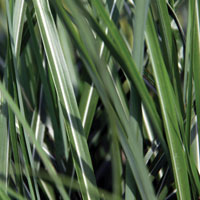10/28/2016
Making Miscanthus Production Easy
Josiah Raymer

Make no mistake: There’s nothing demure about maiden grass. Long an icon of North American grass masses,
miscanthus is equal parts prized for its vigor, size and multi-season impact. Today’s selections combine the best of the genus’ varied offering, including lovely oversized striking plumes and gracefully arching masses of foliage.
Miscanthus’ huge range of cultivars makes it easy to find one for virtually any setting or use.
Two new selections to be sure and check out: Scout has slender green blades with white midribs that take on spectacular fall color. It’s a handsome, infertile form from the University of Georgia’s esteemed program. A sun lover, Scout reaches a mature height of 5 to 6 ft. and is hardy in Zones 5 to 10.
And Fat Cat
(pictured), an Emerald Coast Growers introduction, produces graceful, spherical masses of green leaves with prominent white midribs, turning rich ruby in cool weather. Red flowers soar up to 7 ft. over 3-ft. clumps. Also a sun lover and hardy in Zones 6 to 9.
Sure to be a favorite of consumers as well as growers,
miscanthus make it easy for all. Low maintenance and high impact, they provide great color and texture in the garden both as specimen plants or en masse. Their texture and subtle color take them well into winter before fading, and even then, they maintain the structure and form to add a touch to any dreary landscape.
The good news is producing
miscanthus in the greenhouse is as easy as the crop is on the eyes. With a little care and some attentive growing, you’ll have a crop sure to catch retailers’ and consumers’ attention.
Growing info
•
Miscanthus can grow quite quickly, so the recommended finish size is at least a 1-gal. trade container (a 2- or 3-gal. is also suitable for larger cultivars). Choose a well-draining commercial growing media.
• Maintain soil pH at approximately 5.8 to 6.2 and keep soil electrical conductivity (EC) in the range of 1.8 to 2.2 mS/cm using the 2:1 extraction method.
•
Miscanthus wants high light levels of 5,000 foot candles or more. Provide daytime growing temperatures of 70 to 80F (21 to 26C) and nighttime temperatures of 55 to 65F (12 to 18C). Note that plants will not establish root growth under cool temperatures and short days.
• Plants should be finished for spring sale in approximately eight to 10 weeks.
• Pinching is not required and plant growth regulators generally aren’t needed.
Fertilizer
Provide a constant liquid feed at medium levels of 150 to 200 ppm nitrogen. Be careful not to feed too much too fast or these fast-growing plants may grow too quickly and become weak and floppy.
Moisture level
Allow plants to dry between ample waterings.
Miscanthus are particularly susceptible to overwatering, so be cognizant of their potential for root rot.
Supplemental lighting
Miscanthus requires 12 or more hours photo-period.
Daylength
Miscanthus prefers long days.
Insects and diseases
• Generally, pests and diseases should not be a problem with today’s
miscanthus, provided standard sanitation practices are included in the production plan.
• Ensure a good preventive program is in place, including managing humidity levels and maintaining good air circulation. Scout vigilantly and regularly for pests and diseases, including in particular aphids, mealybugs, spider mites and
miscanthus blight.
• Apply a broad spectrum fungicide drench at liner planting. You may also follow a monthly broad spectrum fungicide control program.
GT
Josiah Raymer is head grower and general manager for Emerald Coast Growers, one of the country’s largest ornamental grass and perennial producers. He can be reached at (877) 804-7277, sales@ecgrowers.com or www.ecgrowers.com.